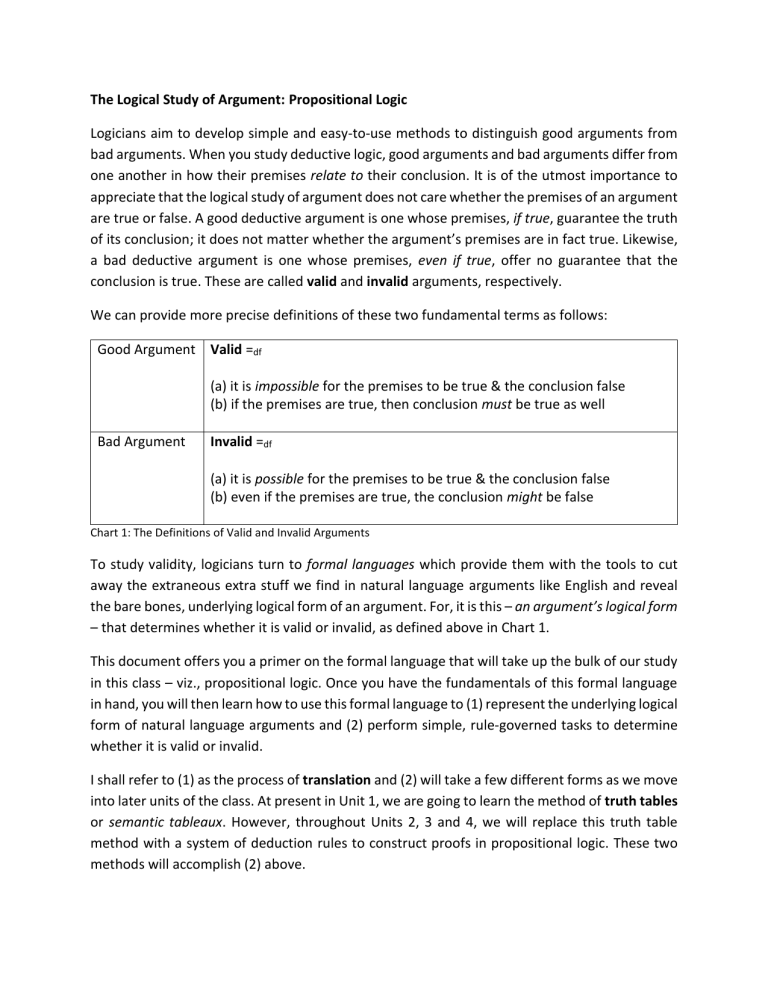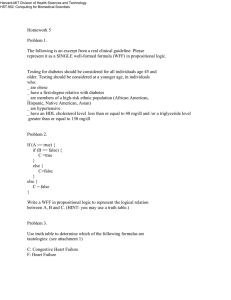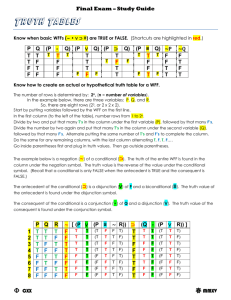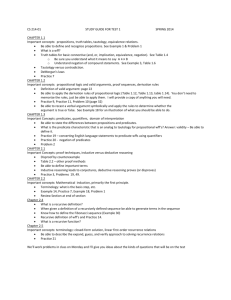
The Logical Study of Argument: Propositional Logic Logicians aim to develop simple and easy-to-use methods to distinguish good arguments from bad arguments. When you study deductive logic, good arguments and bad arguments differ from one another in how their premises relate to their conclusion. It is of the utmost importance to appreciate that the logical study of argument does not care whether the premises of an argument are true or false. A good deductive argument is one whose premises, if true, guarantee the truth of its conclusion; it does not matter whether the argument’s premises are in fact true. Likewise, a bad deductive argument is one whose premises, even if true, offer no guarantee that the conclusion is true. These are called valid and invalid arguments, respectively. We can provide more precise definitions of these two fundamental terms as follows: Good Argument Valid =df (a) it is impossible for the premises to be true & the conclusion false (b) if the premises are true, then conclusion must be true as well Bad Argument Invalid =df (a) it is possible for the premises to be true & the conclusion false (b) even if the premises are true, the conclusion might be false Chart 1: The Definitions of Valid and Invalid Arguments To study validity, logicians turn to formal languages which provide them with the tools to cut away the extraneous extra stuff we find in natural language arguments like English and reveal the bare bones, underlying logical form of an argument. For, it is this – an argument’s logical form – that determines whether it is valid or invalid, as defined above in Chart 1. This document offers you a primer on the formal language that will take up the bulk of our study in this class – viz., propositional logic. Once you have the fundamentals of this formal language in hand, you will then learn how to use this formal language to (1) represent the underlying logical form of natural language arguments and (2) perform simple, rule-governed tasks to determine whether it is valid or invalid. I shall refer to (1) as the process of translation and (2) will take a few different forms as we move into later units of the class. At present in Unit 1, we are going to learn the method of truth tables or semantic tableaux. However, throughout Units 2, 3 and 4, we will replace this truth table method with a system of deduction rules to construct proofs in propositional logic. These two methods will accomplish (2) above. Part 1: The Symbolism of Propositional Logic (1) Propositional Variables (A, B, C, … X, Y, Z) Upper-case letters stand for (a) simple, (b) declarative, (c) positive sentences of English. In particular, what is important to appreciate is that the propositional variables A, B, C, … X, Y, Z are to be used in the place of complete sentences. Sentences have truth-values and there are exactly two such values – true and false – and we assume that every sentence takes one (and only one) of these two values. Here are a few examples to help convey this point. Example1 Moby Dick is a whale “W” stands for [Moby Dick is a whale] Example2 Captain Ahab hates Moby Dick “H” stands for [Captain Ahab hates Moby Dick] Chart 2: the role of upper-case letters in propositional logic (2) Logical Operators ( ~ ∙ ᴠ ⊃ ≡ ) The logical operators are perhaps the most important components of our formal language and are used to represent the occurrence of important logical words in English. The occurrence, placement, and relationship between these logical words and the simple, declarative, positive sentences of English will determine an argument’s underlying logical form. The following chart provides you with English’s important logical words and which of the five logical operators we will use to represent them. Logical Word not Logical Operator ~ (tilde) Operator Name negation Example Translation Moby Dick is not a whale ~W and ∙ (dot) conjunction Socrates is mortal and Aristotle is a philosopher S∙A or ᴠ (wedge) disjunction Socrates is mortal or Aristotle is a philosopher SᴠA if … then … ⊃ (horseshoe) implication, conditional If Moby Dick is a whale, then Captain Ahab hates Moby Dick W⊃H … if and only if … ≡ (triple bar) equivalence, biconditional Socrates is mortal if and only if Aristotle is a philosopher S≡A Chart 3: the logical operators and their English counterparts Let’s take this opportunity to introduce some terminology. We shall call upper-case letters by themselves simple well-formed formulas (or WFFs) of propositional logic. And when we add some logical operators to the mix, these are called complex WFFs. Now, there is an important difference between ‘ ~ ’ and the other four logical operators: the ‘ ~ ’ operates on a single WFF (monadic operator) while the other four logical operators connect two WFFs together (binary operator). For this reason, these last four logical operators are called logical connectives. (3) Parentheses ( … ) or [ … ] The role of parentheses or brackets in propositional logic is to “group” parts of our WFFs together in order to avoid ambiguity. As a general rule, you will need parentheses in your WFF if there are more than two simple WFFs being used in your translation. Additionally, anytime you see English words like ‘either’, ‘both’ or a comma, this is a strong indicator that you will need to “group” parts of the WFF together. When and how parentheses are used is best conveyed by example but the following chart offers some common English sentences that call for parentheses. English Either not A or B Not either A or B Both not A and B Not both A and B WFF (~AᴠB) ~(AᴠB) (~A∙B) ~(A∙B) Chart 4: common English sentences that call for parentheses Part 2: Formation Rules Now that you have some appreciation of the role played by the propositional variables, logical operators, and parentheses in propositional logic, we will need to outline the rules for “building” complex WFFs out of simple WFFs. Just as there are rules for how to put parts of English sentences together to form grammatically correct sentences, propositional logic also has rules to the same end. Luckily for us, propositional logic is a much simpler language than English so its set of formation rules are simple and straightforward (unlike the grammatical rules of English!). ▪ ▪ ▪ Rule (1): Any upper-case letter by itself is a WFF Rule (2): Putting a ‘ ~ ’ in front of any WFF is a WFF Rule (3): Connecting any two WFFs with a ‘ ∙ ’ ‘ ᴠ ’ ‘ ⊃ ’ or ‘ ≡ ’ is a WFF We should understand Rule (2) pertaining to the ‘~’ as stating that this symbol can only ever be placed in front of a WFF. In other words, it says that the ‘~’ can never be used to connect two WFFs together. Additionally, we should understand Rule (3) as stating that the four other mentioned symbols can only ever connect two WFFs together. None of these symbols are allowed to “hang” off the end of a string of symbols or occur one right after another. Part 3: Semantics in Propositional Logic A semantics for propositional logic includes an assignment of a truth-function to each of our five logical operators. Much like the functions you are familiar with from mathematics (e.g., addition, subtraction, multiplication, division, etc.), a truth-function takes an input and produces a corresponding output. Whereas in mathematics the input and output values are numbers, in logic the input and output values are either true (T) or false (F). Below you will see each logical operator’s truth table which is a complete specification of the truth-function assigned to the symbol. Along with the definitions of validity and invalidity, the truth tables for the five logical operators are absolutely essential to succeed in the logical study of argumentation. With the symbolism, formation rules, and semantics of propositional logic in hand, you will soon be able to use these tools to represent the underlying logical form of natural language arguments (translation). With the logical form of an argument revealed, you will first learn how to employ the truth tables or semantic tableaux to determine whether an argument is valid or invalid.






